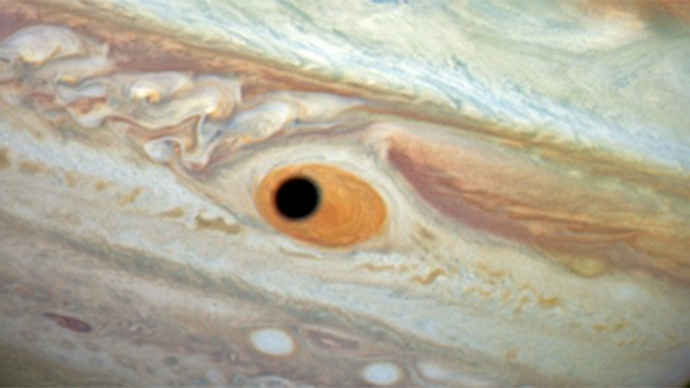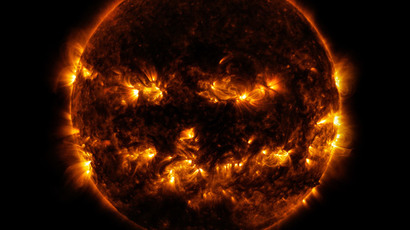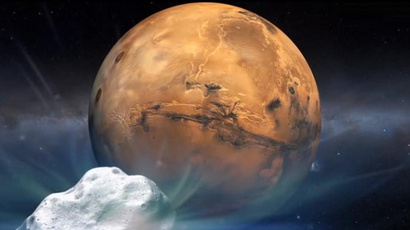Jupiter's ‘one-eyed giant Cyclops’ captured by Hubble

A stunning event captured by NASA’s Hubble Telescope shows a big black eye staring back from Jupiter's Great Red Spot storm. In reality, it is shadow play on a planetary scale.
READ MORE: Space jack-o’-lantern! Amazing images of ‘The Pumpkin Sun’ revealed by NASA
The image was captured by NASA’s Hubble Space Telescope as it
tracked changes in Jupiter’s immense Great Red Spot storm – a
storm that has been raging for over 300 years. The black eye is
caused by the shadow of the Jovian moon, Ganymede, sweeping
across the center of the storm.
“For a moment, Jupiter stared back at Hubble like a one-eyed
giant Cyclops,” a NASA spokesman told the Daily Express.
The Great Red Spot, the largest known vortex in the Solar System
at 10,000 miles wide, is a persistent anti-cyclonic storm just
south of Jupiter's equator. It has been raging for between 300
and 400 years, blowing winds at 345 miles an hour – speeds that
are beyond comparison with even an Earthly Category 5 hurricane,
which can only maximize up to 200 miles.
Astronomers are only beginning to fully understand the complexity
of Jupiter, a gas giant which has a mass 317 times bigger than
Earth. The planet has 62 moons – including four large ones called
the Galilean moons, first discovered by Galileo Galilei in 1610.
Ganymede is the largest of these moons.
Photo: distant-traveller: Just in time for Halloween: Jupiter gets a giant cyclops eye! Jupiter’s Great Red... http://t.co/MtVPlYHL9b
— Francisco Martínez (@japapacho) October 30, 2014
Jupiter’s atmosphere is made up of mostly hydrogen and helium
gas, just like the sun. The planet's surface is covered in thick
red, brown, yellow, and white clouds, and spins faster than any
other planet, with a day only about 10 hours long.
What scientists also know is that it has an extremely powerful
magnetic field. Deep under its clouds is a huge ocean of liquid
metallic hydrogen, and as the planet spins, the liquid metal
ocean rotates and powers the metallic field, according to NASA.
Like Earth, Jupiter experiences aurora borealis but they are
hundreds of times more energetic – and they never stop.
“We see them every time we look,” said Randy
Gladstone of the Southwest Research Institute in San Antonio,
Texas. “Jupiter has auroras bigger than our entire
planet.”
The images are the latest remarkable pictures to be discovered by
the Hubble Telescope, which was launched into orbit in 1990 and
named after the American astronomer Edwin Hubble. It was Hubble
who discovered the universe is expanding. The telescope has
captured tens of thousands of images of planets, stars, nebulae,
and galaxies, according to the Daily Express.

In August 2011, NASA launched Juno – a new mission to study
Jupiter in detail. The spacecraft will arrive in late 2016. The
goal of Juno is to help scientists understand the origin and
evolution of Jupiter, and how planets form.
Juno will orbit closer to the planet than any previous
spacecraft, and will use Jupiter’s powerful magnetic field,
gravity field, and naturally occurring radio waves to study the
planet’s interior. The spacecraft will also study its polar
region and aurora borealis.
The next planned mission will be the European Space Agency's
Jupiter Icy Moon Explorer (JUICE), due to launch in 2022.
READ MORE: Cosmic Chaos: Turbulence prevents cluster galaxies from forming stars (PHOTO)
Like Earth, Jupiter experiences aurora borealis but they are hundreds of times more energetic – and they never stop.
“We see them every time we look,” said Randy Gladstone of the Southwest Research Institute in San Antonio, Texas. “Jupiter has auroras bigger than our entire planet.”
The images are the latest remarkable pictures to be discovered by the Hubble Telescope, which was launched into orbit in 1990 and named after the American astronomer Edwin Hubble. It was Hubble who discovered the universe is expanding. The telescope has captured tens of thousands of images of planets, stars, nebulae, and galaxies, according to the Daily Express.
In August 2011, NASA launched Juno – a new mission to study Jupiter in detail. The spacecraft will arrive in late 2016. The goal of Juno is to help scientists understand the origin and evolution of Jupiter, and how planets form.
Juno will orbit closer to the planet than any previous spacecraft, and will use Jupiter’s powerful magnetic field, gravity field, and naturally occurring radio waves to study the planet’s interior. The spacecraft will also study its polar region and aurora borealis.
The next planned mission will be the European Space Agency's Jupiter Icy Moon Explorer (JUICE), due to launch in 2022.
READ MORE: Earth to face a 6-day blackout, viral hoax cites NASA as saying














